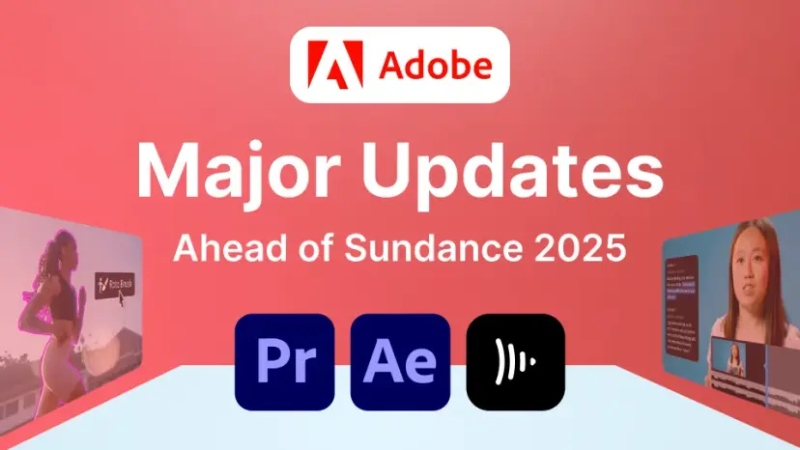
Just in time for the 2025 Sundance Film Festival, Adobe released major updates to its flagship video and motion design tools, Premiere Pro, After Effects, and Frame.io. By eliminating time-consuming procedures and promoting greater creativity, these improvements seek to optimize the workflows of motion designers, editors, and filmmakers.
Adobe has released major beta updates for Premiere Pro, After Effects, and Frame.io with the goal of enhancing creative workflows and accelerating post-production. These updates coincide with the 2025 Sundance Film Festival, when Adobe says that 85% of submissions used Adobe Creative Cloud features, further solidifying the software giant’s position as the industry leader.
These latest updates demonstrate Adobe’s efforts to remain innovative, but they also draw attention to some of the persistent challenges experienced as an editor. The software’s dependability and high subscription fees still offer cause for annoyance, despite their obvious effort on providing us with new and creative tools—sometimes ones we weren’t even aware we needed. It’s difficult to avoid contrasting that with reliable and reasonably priced options like DaVinci Resolve, which nonetheless provide good functionality without the same issues.
The primary goal of Premiere Pro’s (beta) updates is to increase editors’ productivity. The Media Intelligence system, which automatically tags and recognizes visuals in your video using AI, is a noteworthy feature. Editors may use natural language to rapidly locate particular footage thanks to this metadata, which includes objects, locations, camera angles, and other information.
When you type “wide shot of a desert landscape” into the new Search window, for example, pertinent results will appear right away. This feature is revolutionary for large-scale projects since it removes the need for hours of laborious scrubbing through footage.
Premiere’s caption translation feature, which automatically generates multilingual captions in 17 languages, is another significant development. This functionality guarantees that editors may reach a worldwide audience with their content without adding undue time or price to their workflows, as captions are becoming important to accessibility and audience engagement. Additionally, Adobe supports several caption tracks, which helps editors create content more quickly for a range of audiences.
The emphasis on performance in the most recent version of After Effects (beta) will be appreciated by motion designers. A significant improvement is the enhanced caching mechanism, which makes use of both RAM and hard drives to enable quicker previews and playing of longer, more intricate compositions. Large-scale projects can now be handled by even older systems with fewer disruptions, maintaining the creative energy.
An additional advancement is the upgraded HDR support. High-dynamic-range (HDR) motion designers can now precisely track and export their work, guaranteeing that vibrant, captivating images retain their quality throughout the whole production process. The workflow enhancements make creating HDR content easier than ever, regardless of whether you’re using a laptop or a high-end display.
Canon C400 and C80 Native Camera to Cloud using Frame.io
For a Canon enthusiast, this is among the most exciting upgrades to Frame.io. During production, proxy files can be automatically posted to Frame.io thanks to this feature. Editors and story producers can start working on video practically instantly, even while production is going on because there is no need for manual file transfers.
By detecting and resolving problems early, this integration minimizes delays and lowers the possibility of expensive reshoots while facilitating real-time team collaboration. All things considered, turnaround times are getting shorter, and the quick-paced film industry is only getting faster. Post teams may evaluate video more quickly thanks to the C2C workflow, which allows them to polish edits and finalize their work before deadlines.
To begin uploading video to the Cloud in a matter of minutes, all you need is a Frame.io account, a Canon C80 or C400, a network connection, and a short six-digit pairing code. As someone who produces documentaries in large teams, can see how this may be quite beneficial. Having everything ready to review and edit so fast makes it much simpler to stay organized and keep the entire team on track when you’re dealing with a lot of video and tight deadlines.
These Premiere Pro and After Effects features are all currently available in beta.
Adobe reports that 85% of this year’s Sundance entries use its technologies, demonstrating that it is still a preferred choice for filmmakers. Adobe software was used for editing movies including “Opus” and “Train Dreams.” With an extra $5 million given to the Adobe Film & TV Fund, the company has further strengthened its commitment to diversity, increasing its total investment to $11 million.
The beta version of all features is now accessible. Adobe invites users of Creative Cloud to test the upgrades and provide feedback.
Dr. Rema Vassar is a leading advocate for equity in education, particularly in ensuring that… Read More
Exploring the world of guitar music is a journey into the heart of creativity, where… Read More
Marine construction is a vital field that shapes coastal infrastructure, energy production, and global connectivity.… Read More
The history of the United States is a story of resilience, transformation, and progress. From… Read More
Couples' financial planning helps them to realize their shared objectives and cohesive tactics, therefore turning… Read More
A Young Entrepreneur’s Visionary Talks with a Global Economic Leader Signal a Bold Future In… Read More